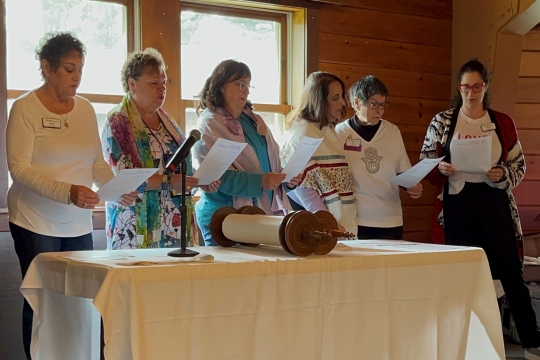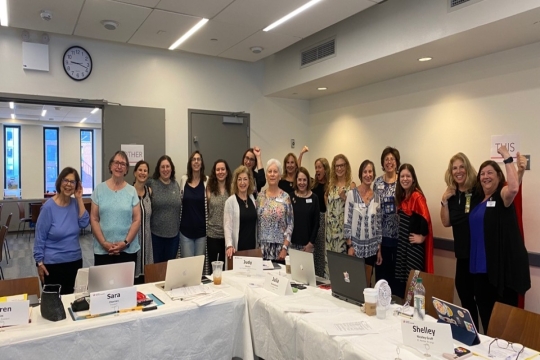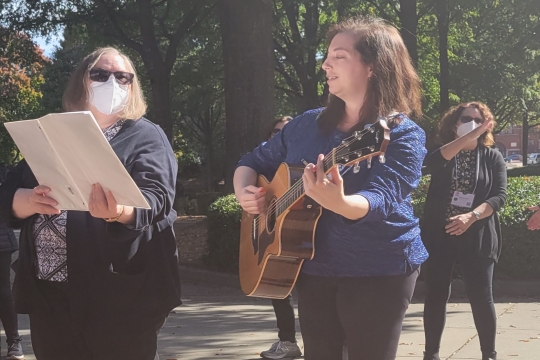“Why?” As children, we wonder about the color of the sky, and we ponder the rules of the games of the playground. Eventually, we start to ask bigger “why” questions: Why do some people have everything when others have nothing? Why do bad things happen to good people? The questions never cease. Even when the questions are hard or the answers are not apparent, it is human nature to ask. This is the way that God created us. When the mysteries of life puzzle us, we still seek to understand.
The Torah portion for this week seems to offer us more questions than answers. The events of Parshat Shemini seem to have nothing to do with one another. The parshah opens with the official dedication of the Tabernacle and the ordination of Aaron and his sons after a week of rituals (Leviticus 9:1-4). They become the priests of Israel, the only individuals permitted to approach God so closely and enact rituals to maintain God’s presence in Israel.
Just as this joyous sacred occasion ends, an event of tragedy and mystery occurs. Aaron’s sons, Nadav and Avihu, offer an eish zarah, a strange fire, to Adonai (10:1). For this offering, which they are not commanded to bring, they are instantly incinerated and killed (10:2). Why would these two ordained priests bring this unsanctioned offering? What is this terrifying story doing in Leviticus in the first place? Just when the sudden violence of this moment could not be any more shocking, what happens next is even more troubling. Moses explains the death of Aaron’s sons through a cryptic message from God: “This is what Adonai meant when He said: ‘Through those near to Me I show Myself holy, and gain glory before all the people.’ And Aaron was silent.” Aaron fell silent in the face of this explanation, and Aaron’s relatives took the burned bodies of his two sons away. What was Aaron feeling in that moment? Why doesn’t he cry out to God? The text leaves us to wonder why.
The final section of this Torah portion, Leviticus 11, lays out the rules regarding animals that may and may not be eaten. The questions these restrictions bring up in the text are the same questions that many of us ask today when we learn about kashrut, the dietary laws. Why are certain animals considered pure and others are not? Why are grasshoppers permitted and other insects are forbidden? The final lines of the parshat explain that the Israelites are to obey these laws to be holy, because God is holy (11:45). The Torah offers no further moral, nutritional, or social norms as justification. The people are commanded to maintain their own purity and distinguish between the things that may and may not be eaten, period.
Why are these three distinct pieces of text woven together? In my own attempts to understand, I have discerned a link that I hope might help others find new meaning in this Torah portion. In the cases of Nadav and Avihu and the laws of kashrut, the reader is asked to hold a particular tension: both narratives challenge us to follow a strict, structured path given by the tradition, while also having to embrace the mystery of those obligations. It is natural to want to understand why one does something before doing it, but that is not always possible. Nadav and Avihu make an offering to God, but they break the rules for sacrifices that they were meant to uphold. When God commands the Israelites to distinguish for themselves between what is pure and what is impure, the way they eat and live their lives is changed forever. In their effort to be a holy community, they must accept that these rules must be enough. Holiness is meaning enough-- no other explanations are given.
What do these seemingly incongruous texts come to teach us? I believe that Parshat Shemini calls on us to do two things:
Embrace the mystery in life. In life, there are some things we may simply never understand. Accepting this truth is an important part of coping with life’s challenges and troubles. Parshat Shemini invites us to notice the mystery and see that it has a place. We may never understand Aaron’s experience. We might drive ourselves crazy trying to explain why a split hoof makes one animal pure and holy. We might also never know why one friend’s parent had cancer or why someone’s home is swept away by a hurricane. Embracing mystery in life can open us up to deeper forms of prayer, to a new relationship with our spiritual selves, or to new ways of understanding the world around us.
Continue to ask questions and make your own meaning. The most important lesson about asking “Why?” is that merely asking the question can help us make our own meaning. The rabbinic tradition of interpreting the Torah spans across the centuries, and those great sages were never merely satisfied with asking questions. They demanded answers. For the narrative of Nadav and Avihu, they come up with dozens of reasons for their deaths and the exact nature of their sin. Everyone from anthropologists to Torah scholars has explored the origins of the laws of kashrut to understand their social and religious meaning. Today, people see abiding by the rules for kosher animals as a marker of Jewish identity, a spiritual practice of mindfulness, and much more. As Jews, we learn that when the tradition does not give us the answers, we can and should find answers of our own. When we ask “why,” we begin a journey towards understanding that only we have the power and opportunity to create.
Lori Levine is in her final year of rabbinical school at HUC-JIR in Los Angeles and a graduate of the Rhea Hirsch School of Education. She currently serves as the Rabbinic Intern at Congregation Or Ami in Calabasas, CA. Lori is a YES fund scholarship recipient.
Related Posts

Parashat Yom Rishon shel Rosh HaShanah

Cultivating a Culture of Accountability and Belonging

